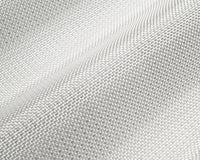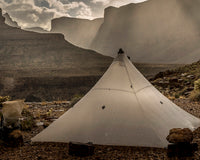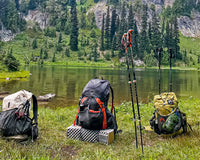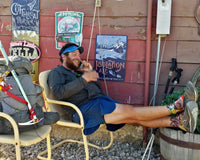
Even at the edges of my earliest memories, I've only known one type of sock. You know … the regular kind that you get for your birthday or during the holidays. It wasn't until I started trail running around Arizona that I even learned about the blessed toe sock. Since then, they have been my go-to sock of choice on trail runs and backpacking trips.
Test Locations: Trail running in the Sonoran Desert, as well as backpacking through the San Juans, the Sawtooth Wilderness, and the Guadalupe Mountains.

Airing out the Injinji Coolmax with a view of the Grand Canyon (October 2021).
The Pros
Blister Protection. In regular mitten shipped socks, your toes are kept cramped together, which often leads to friction between the toes, resulting in painful blisters. Toe socks separate your digits with cooling fabric, thus mitigating the skin-to-skin contact that causes blisters.
Better Ground Feel. Minimalist, barefoot, and zero-drop footwear have become incredibly prevalent since Born to Run by Christopher McDougall was published in 2009. Toe socks, like those made by Injinji, perfectly complement the barefoot mentality, allowing toes to splay more naturally. As someone who suffers from chronic knee and back pain, having a solid feel and understanding of the terrain underneath my feet is particularly valuable to me.

Breathability. Toe socks are excellently built to keep your feet cool and dry. They cover almost every millimeter of your foot with wicking fabric, which gives them more surface area to evaporate the sweat from your feet — similar to how baselayers typically function. Your toes are also separated from each other, keeping them from warming each other up via body heat in close quarters.
Comfort. The added breathability of toe socks, with the increased ground feel resulting from additional toe splay, and the overall superior blister protection toe socks provide, create a comfortable and enjoyable ride for your feet. Comfort is paramount when your feet carry your entire body over a rugged trail. Specifically true of both the synthetic and merino wool Injinji socks, they are incredibly soft and provide ample cushioning. Injinjis also avoid invasive seams, which could irritate your feet while on the move.
Dad-Mode. If you’re looking to look cool out on the trail or in town for a resupply, simply add ultralight sandals to your Injinji socks to achieve full “Dad Mode.” It’s all the rage these days, give it a try and thank me later.

Dad-Mode Activated. The Injinji Midweight Socks paired with the perfect camp shoes, the Ultralight Mayfly Imago.
The Cons
Finicky. When you first start using toe socks, there can be a learning curve. You can't just shove your foot in and go. You have to align your five little toes into five little separate holes and shimmy them in individually. It's a cumbersome exercise in defiance of simplicity. Nonetheless, it does get easier over time, so it's not THAT big of a deal. I can even manage to wiggle my little piggies into their homes from the warmth of my quilt in the dim light of dawn.
Wear and Tear. Because the socks take the same shape around your feet every time you put them on, they acquire wear and tear much quicker than their mitten-shaped counterparts — a fact that is especially true of my favorite merino wool Injinji socks. The friction spots are continuously worked and whittled over time, while a traditional sock offers some variation in how you can wear them.
The Injinji NuWool version uses only 31% nylon to reinforce and strengthen the integrity of the sock, while the all synthetic equivalent lightweight version uses more than double the nylon, at 68%. Within a hundred miles, the merino wool socks began to thin around the ball of my foot, as well as right at the tip of my big toe. Comparatively, the synthetic version looks no worse for wear under the same stress.
However, this is not a deal breaker for me. Socks are like tools — you have to pick the right ones for the trip at hand. Spending a week out in the Sawtooth Wilderness? The NuWool Injinji will shine! Need to wear the same pair of socks over three hot and humid months? Maybe reach for the Coolmax Injinji instead.

The weights of the three Injinji socks I wear in grams. On the left, the NuWool Lightweight with ultra-thin cushioning. In the middle, the Coolmax Midweight with padded cushioning. On the right, the Coolmax Original Weight with thin Cushioning. For reference, I have a size 11.5 foot, and wear a size Large in Injinji.
TLDR
Toe socks are a great way to increase the enjoyment of your favorite outdoor activity by providing more breathability, better ground feel, and improved blister protection over more traditional sock designs.
Rafael is a freelance writer and adventurer based in the Mountain West. You can find him trail running, backpacking, or sampling the best tacos during his free time. Follow all his adventures over on Instragam @horsecake22, or read more of his work on his website.
















5 comments
Kim Kremer
I’ve grown disenchanted with Injinji’s socks because of how quickly they wear out. My first few pairs were great; more recently, they’ve developed holes within a few wearings. I rarely get blisters — a great blessing, I know — but wearing a sock with a hole in it is going to cause my feet some distress.
I don’t see how regular socks cause your toes to be “cramped together.” If the socks fit and your shoes have a large enough toe box, you should be able to splay your toes.
Kim Kremer
I’ve grown disenchanted with Injinji’s socks because of how quickly they wear out. My first few pairs were great; more recently, they’ve developed holes within a few wearings. I rarely get blisters — a great blessing, I know — but wearing a sock with a hole in it is going to cause my feet some distress.
I don’t see how regular socks cause your toes to be “cramped together.” If the socks fit and your shoes have a large enough toe box, you should be able to splay your toes.
DEA
Right out of the gate I loved the socks. True it takes an extra minute or two to pull them on with alignment issues multiplied by five. Not having worn them before the feel is unique. Blisters, well they are nonexistent. So my only con, holes forty miles in was a deal breaker for me. Maybe a fine spun Kevlar added to the mix would lengthen the life expectancy.
Jan
I have been wearing injinjies for almost 10 years (not the same pair, that would be yuck!).
I can totally agree with the review and add a couple more “good to know” items.
- The socks will get less stretchie over time so you know when you can’t get those toes in as easily…..stop batting and get a new pair!
- Also consider that the extra material between your toes can make your footprint wider needing a slightly bigger sized shoe.
Roseanne Adams
Love them for sock liners when backpacking! Since I started wearing toe socks I have not gotten blisters! yes, can be difficult to put on, but with no blisters, who cares! Even on my toes that are working toward hammer toes